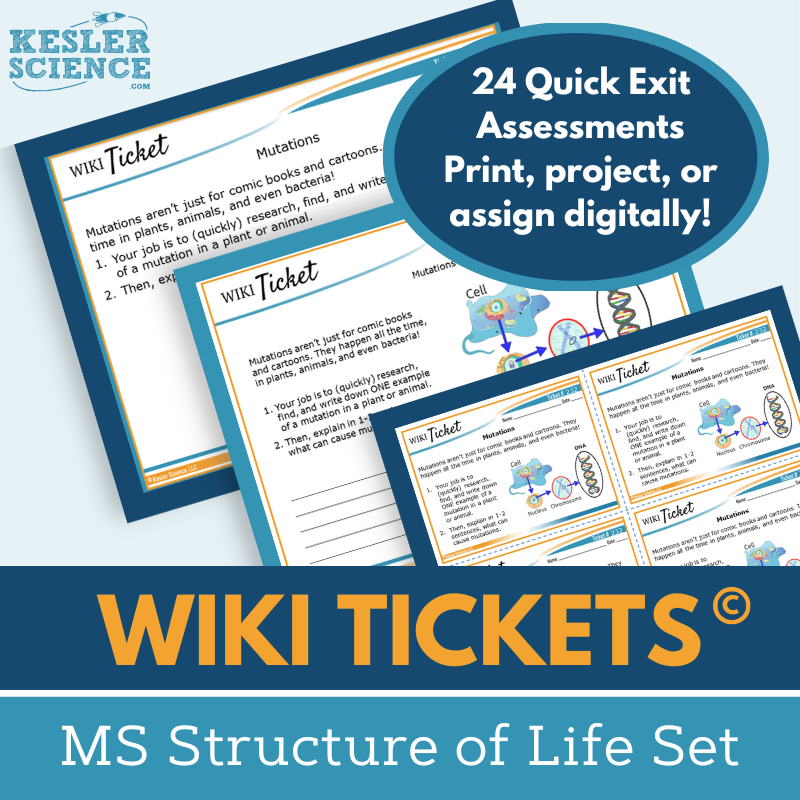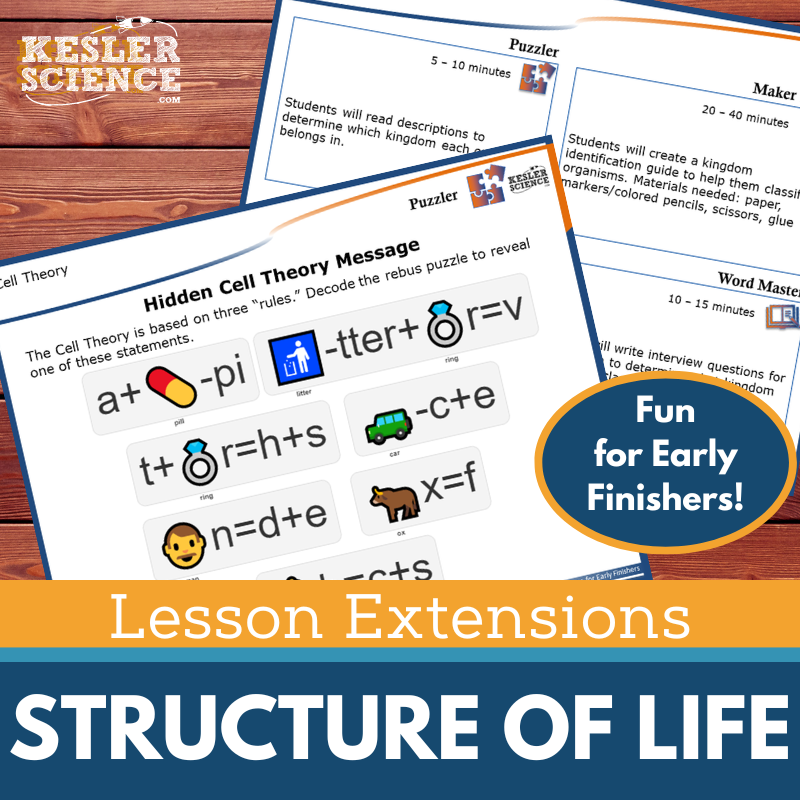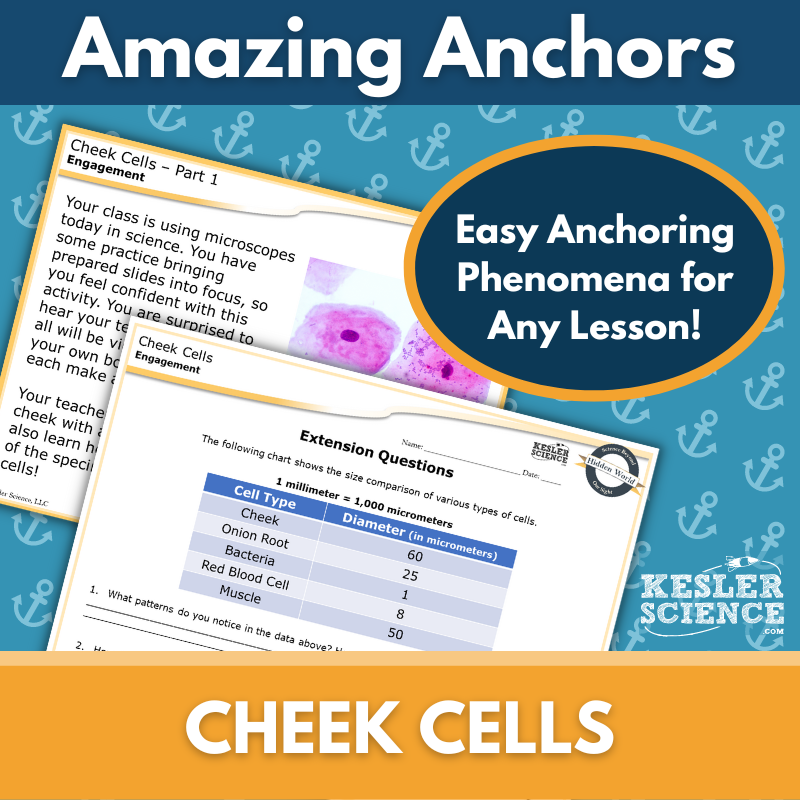Comparing Organisms Activities for Middle School Science
The Kesler Science Comparing Organisms 5E Lesson guides middle school students in identifying and comparing the characteristics of organisms, including prokaryotic and eukaryotic, unicellular and multicellular, and autotrophic and heterotrophic. The resources below will give students a comprehensive understanding of the characteristics of organisms. All of the following materials are also included in the Kesler Science Membership.
The Kesler Science Comparing Organisms 5E Lesson is a comprehensive life science unit designed to help middle school students identify and compare the basic characteristics of organisms, including prokaryotic and eukaryotic, unicellular and multicellular, and autotrophic and heterotrophic. This low-prep, student-led lesson includes editable presentations, worksheets, choice projects, and assessments, all aligned with the 2021 TEKS 6.13B standard.
Following the 5E Model, the unit begins with engaging objectives, word wall cards, and discussion activities in English and Spanish. The exploration phase features a differentiated, student-led station lab with hands-on, reading, research, and video-based activities. Output stations allow students to demonstrate understanding through categorization, writing, drawing, and assessments, with an optional challenge station for extension.
The explanation phase offers editable PowerPoints, interactive notebooks, and note-taking templates. Students can extend their learning through creative choice projects, while assessments and review materials help evaluate their mastery of the content. Designed for flexibility, this lesson supports both in-class and virtual learning environments.
The Kesler Science Comparing Organisms 5E Lesson is a comprehensive life science unit designed to help middle school students identify and compare the basic characteristics of organisms, including prokaryotic and eukaryotic, unicellular and multicellular, and autotrophic and heterotrophic. This low-prep, student-led lesson includes editable presentations, worksheets, choice projects, and assessments, all aligned with the 2021 TEKS 6.13B standard.
Following the 5E Model, the unit begins with engaging objectives, word wall cards, and discussion activities in English and Spanish. The exploration phase features a differentiated, student-led station lab with hands-on, reading, research, and video-based activities. Output stations allow students to demonstrate understanding through categorization, writing, drawing, and assessments, with an optional challenge station for extension.
The explanation phase offers editable PowerPoints, interactive notebooks, and note-taking templates. Students can extend their learning through creative choice projects, while assessments and review materials help evaluate their mastery of the content. Designed for flexibility, this lesson supports both in-class and virtual learning environments.
Engage your middle school class with this student-led station lab aligned with the 2021 TEKS 6.13B standard. This life science lesson helps students identify and compare basic characteristics of organisms, including prokaryotic and eukaryotic, unicellular and multicellular, and autotrophic and heterotrophic. Designed for in-class or virtual learning, the lab promotes active participation while saving prep time.
Students navigate nine differentiated stations independently or in small groups, fostering personalized learning with activities that include demonstrations, videos, readings, and research. The Explore It! station features hands-on tasks or digital activities using PowerPoint or Google Slides. Watch It! and Read It! stations introduce new concepts through videos and reading passages, available in English and Spanish. The Research It! station deepens understanding through facts, images, and graphs.
Students then demonstrate their knowledge through Organize It!, Illustrate It!, Write It!, and Assess It! stations, where they engage with manipulatives, draw models, respond to prompts, and answer assessment questions. A Challenge It! bonus station offers extension activities like crosswords, games, and mini-projects for advanced learners. This low-prep, high-engagement resource supports critical thinking and independent learning.
Engage your middle school class with this student-led station lab aligned with the 2021 TEKS 6.13B standard. This life science lesson helps students identify and compare basic characteristics of organisms, including prokaryotic and eukaryotic, unicellular and multicellular, and autotrophic and heterotrophic. Designed for in-class or virtual learning, the lab promotes active participation while saving prep time.
Students navigate nine differentiated stations independently or in small groups, fostering personalized learning with activities that include demonstrations, videos, readings, and research. The Explore It! station features hands-on tasks or digital activities using PowerPoint or Google Slides. Watch It! and Read It! stations introduce new concepts through videos and reading passages, available in English and Spanish. The Research It! station deepens understanding through facts, images, and graphs.
Students then demonstrate their knowledge through Organize It!, Illustrate It!, Write It!, and Assess It! stations, where they engage with manipulatives, draw models, respond to prompts, and answer assessment questions. A Challenge It! bonus station offers extension activities like crosswords, games, and mini-projects for advanced learners. This low-prep, high-engagement resource supports critical thinking and independent learning.
The Comparing Organisms Student Choice Projects align with the 2021 TEKS standard 6.13B, offering middle school students a variety of project options to suit their preferred output style. A project page outlines six student-led choices plus a “design your own” project, all supported by an editable rubric for teacher, peer, or self-assessment. This resource is also part of the Comparing Organisms Complete Lesson for TEKS 6.13B.
These flexible, creative projects allow students to demonstrate their understanding in personalized ways. Two versions of the project page support differentiation, with modified options for students needing extra support and advanced challenges for those ready for more. The rubric can be adjusted to meet grading needs.
The projects use standard classroom supplies like paper, markers, and scissors, and many can also be completed digitally.
The Comparing Organisms Student Choice Projects align with the 2021 TEKS standard 6.13B, offering middle school students a variety of project options to suit their preferred output style. A project page outlines six student-led choices plus a “design your own” project, all supported by an editable rubric for teacher, peer, or self-assessment. This resource is also part of the Comparing Organisms Complete Lesson for TEKS 6.13B.
These flexible, creative projects allow students to demonstrate their understanding in personalized ways. Two versions of the project page support differentiation, with modified options for students needing extra support and advanced challenges for those ready for more. The rubric can be adjusted to meet grading needs.
The projects use standard classroom supplies like paper, markers, and scissors, and many can also be completed digitally.
The Prokaryotic and Eukaryotic Cells Inquiry Lab helps students recognize the presence of a nucleus as a key factor in determining whether a cell is prokaryotic or eukaryotic. Students will sort cell images into prokaryotes and eukaryotes, then create a model of an animal, plant, or bacterial cell. Through a gallery walk, they will explain their models and the importance of the nucleus.
This resource offers three differentiated labs to support diverse learners: a dependent lab with guided instructions for on-level learners, a modified lab with structured support for those needing accommodations, and an independent lab that encourages advanced students to take the lead in their learning.
The resource includes teacher pages with preparation guidance, objectives, and materials lists, along with answer keys, editable pages, and reflection questions to guide students through claim, evidence, and reasoning statements. Common household materials like cell image pages, sandwich bags, plastic eggs, spice bottles, and beads can be used for model creation.
The Prokaryotic and Eukaryotic Cells Inquiry Lab helps students recognize the presence of a nucleus as a key factor in determining whether a cell is prokaryotic or eukaryotic. Students will sort cell images into prokaryotes and eukaryotes, then create a model of an animal, plant, or bacterial cell. Through a gallery walk, they will explain their models and the importance of the nucleus.
This resource offers three differentiated labs to support diverse learners: a dependent lab with guided instructions for on-level learners, a modified lab with structured support for those needing accommodations, and an independent lab that encourages advanced students to take the lead in their learning.
The resource includes teacher pages with preparation guidance, objectives, and materials lists, along with answer keys, editable pages, and reflection questions to guide students through claim, evidence, and reasoning statements. Common household materials like cell image pages, sandwich bags, plastic eggs, spice bottles, and beads can be used for model creation.
This Prokaryotic and Eukaryotic Cells Science Reading Comprehension Lesson helps students explore the differences between prokaryotic and eukaryotic cells, including the presence of a nucleus, through a nonfiction article, comprehension questions, and a comparison activity. Designed for grades 6–8, the leveled passage supports science literacy and reading comprehension.
The resource includes two leveled articles (Lexile levels 1100–1300), five to seven comprehension questions, a hands-on mini-project, and a Cornell notes template. It features engaging graphics that can be printed in grayscale.
This lesson is suitable for both in-person and virtual learning environments, compatible with platforms like Google Classroom, MS Teams, Schoology, and Canvas. Students can complete activities directly in the document using PowerPoint or Google Slides.
Ideal for sub plans, extra credit, ISS, or whole-class instruction, this resource encourages critical thinking, classroom discussions, and textual analysis while reinforcing key cell biology concepts.
This Prokaryotic and Eukaryotic Cells Science Reading Comprehension Lesson helps students explore the differences between prokaryotic and eukaryotic cells, including the presence of a nucleus, through a nonfiction article, comprehension questions, and a comparison activity. Designed for grades 6–8, the leveled passage supports science literacy and reading comprehension.
The resource includes two leveled articles (Lexile levels 1100–1300), five to seven comprehension questions, a hands-on mini-project, and a Cornell notes template. It features engaging graphics that can be printed in grayscale.
This lesson is suitable for both in-person and virtual learning environments, compatible with platforms like Google Classroom, MS Teams, Schoology, and Canvas. Students can complete activities directly in the document using PowerPoint or Google Slides.
Ideal for sub plans, extra credit, ISS, or whole-class instruction, this resource encourages critical thinking, classroom discussions, and textual analysis while reinforcing key cell biology concepts.
The Prokaryotic and Eukaryotic Cells Science Writing Prompt Activity gives middle school students the necessary materials to test their knowledge about life science! It uses a compare & contrast essay to create fun and engaging exercises for students. Extend your students’ science reasoning and exploration as they enrich their own writing. Each product has been created to allow for virtual learning so middle school science students can stay engaged even outside of the classroom.
The Prokaryotic and Eukaryotic Cells Science Writing Prompt Activity gives middle school students the necessary materials to test their knowledge about life science! It uses a compare & contrast essay to create fun and engaging exercises for students. Extend your students’ science reasoning and exploration as they enrich their own writing. Each product has been created to allow for virtual learning so middle school science students can stay engaged even outside of the classroom.
The Structure of Life WIKI Tickets© formative assessments provide an engaging way to check student understanding in 6th-8th grade science. This set includes 24 assessments, each available in five formats: a full-screen projection version, three printable handout sizes (full, split, and quarter-page), and an interactive digital version compatible with PowerPoint and Google Slides. Aligned with NGSS and TEKS standards, every topic has at least one corresponding assessment, with some standards covered by multiple tickets. A helpful table of contents is also included to show standard alignment.
These assessments cover essential life science concepts such as asexual and sexual reproduction, cell function and theory, animal and plant cells, heredity, genetic mutations, CRISPR, food chemistry, and homeostasis. Designed for flexibility, WIKI Tickets© can be used as exit tickets, bellringers, or quick checks in both in-person and virtual learning environments. Whether projecting for class discussions, distributing printed handouts, or assigning digital copies for remote learning, these assessments help gauge student understanding effectively at any point in the lesson.
The Structure of Life WIKI Tickets© formative assessments provide an engaging way to check student understanding in 6th-8th grade science. This set includes 24 assessments, each available in five formats: a full-screen projection version, three printable handout sizes (full, split, and quarter-page), and an interactive digital version compatible with PowerPoint and Google Slides. Aligned with NGSS and TEKS standards, every topic has at least one corresponding assessment, with some standards covered by multiple tickets. A helpful table of contents is also included to show standard alignment.
These assessments cover essential life science concepts such as asexual and sexual reproduction, cell function and theory, animal and plant cells, heredity, genetic mutations, CRISPR, food chemistry, and homeostasis. Designed for flexibility, WIKI Tickets© can be used as exit tickets, bellringers, or quick checks in both in-person and virtual learning environments. Whether projecting for class discussions, distributing printed handouts, or assigning digital copies for remote learning, these assessments help gauge student understanding effectively at any point in the lesson.
Lesson Extensions offer engaging, student-choice activities designed to challenge early finishers and deepen their understanding of life science concepts aligned with NGSS and TEKS standards. These activities help reinforce critical thinking, creativity, and problem-solving while keeping students engaged during downtime, lesson wrap-ups, or testing periods.
Each extension features four interactive components: Puzzler for problem-solving challenges, Maker Space for hands-on STEAM activities, Tech Connection for digital learning demonstrations, and Word Master for creative writing tasks. Resources include teacher directions, answer keys, and both digital projection and printable versions for flexible classroom use.
Covering topics such as artificial selection, body systems, cell functions, organelles, dichotomous keys, genetic mutations, heredity, kingdoms, natural selection, and reproductive success, these extensions offer rigorous, independent learning opportunities that encourage students to dive deeper into life science concepts.
Lesson Extensions offer engaging, student-choice activities designed to challenge early finishers and deepen their understanding of life science concepts aligned with NGSS and TEKS standards. These activities help reinforce critical thinking, creativity, and problem-solving while keeping students engaged during downtime, lesson wrap-ups, or testing periods.
Each extension features four interactive components: Puzzler for problem-solving challenges, Maker Space for hands-on STEAM activities, Tech Connection for digital learning demonstrations, and Word Master for creative writing tasks. Resources include teacher directions, answer keys, and both digital projection and printable versions for flexible classroom use.
Covering topics such as artificial selection, body systems, cell functions, organelles, dichotomous keys, genetic mutations, heredity, kingdoms, natural selection, and reproductive success, these extensions offer rigorous, independent learning opportunities that encourage students to dive deeper into life science concepts.
This Amazing Anchors Phenomenon Lesson introduces prokaryotic and eukaryotic cells through an engaging, real-world connection using cheek cells. It begins with an introductory reading accompanied by comprehension and extension questions to prepare students for deeper learning, followed by an explanatory reading that breaks down the differences between cell types in an accessible way, with additional questions for reinforcement.
This no-prep resource includes teacher directions, answer keys, projection slides, and both print and digital formats for Google Classroom or other LMS platforms. A differentiated version supports students with simplified language and sentence starters. Designed to bookend any science lesson, this resource effectively reinforces learning in both in-person and virtual classrooms.
This Amazing Anchors Phenomenon Lesson introduces prokaryotic and eukaryotic cells through an engaging, real-world connection using cheek cells. It begins with an introductory reading accompanied by comprehension and extension questions to prepare students for deeper learning, followed by an explanatory reading that breaks down the differences between cell types in an accessible way, with additional questions for reinforcement.
This no-prep resource includes teacher directions, answer keys, projection slides, and both print and digital formats for Google Classroom or other LMS platforms. A differentiated version supports students with simplified language and sentence starters. Designed to bookend any science lesson, this resource effectively reinforces learning in both in-person and virtual classrooms.
Year-Round Resources
These year-round activities will increase your students' understanding of many middle school science topics. All of these activities are also included in the Kesler Science Membership.
Visual Data & Graphing
You're not alone if your students struggle with understanding graphs, charts, and tables. It's a skill that takes an enormous amount of practice. This resource will help students build a strong foundation in analyzing data and creating their own data visualizations.
Bell Ringers and Warm-Ups
These middle school science bell ringers are an excellent way to engage your students as soon as they walk into your classroom. This comprehensive FULL YEAR resource includes everything you need to start off each science class with an interesting warm-up activity.
Review Board Games
Each game board has been carefully designed to keep students engaged. There are 10 different action spaces on each board and dozens of question cards. All of the actions are related to science concepts and keep the students motivated throughout the game.
Each game is ready to play. Simply print out the board and the cards and let the students enjoy reviewing nine different units.
Essential Questions and Standards
Below are the essential questions and standards associated with the lessons and activities included in the atoms unit. This topic is only one of more than 100 middle school science topics included in the Kesler Science Membership.
-
How do the terms in each pair of characteristics compare to one another: prokaryote and eukaryote, multicellular and unicellular, and autotroph and heterotroph?
-
TEKS Science - 6.13B Comparing Organisms
Kesler Science Membership
Imagine never having to search for another middle school science lesson again. The membership gives you access to ALL of the Kesler Science products in one place (Yes, including everything above).
Say goodbye to long hours of lesson prep.



















